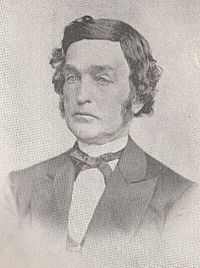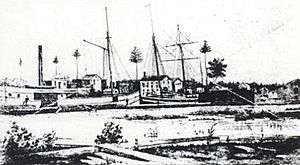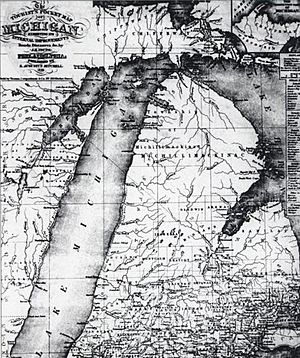Charles Mears facts for kids
Quick facts for kids
Charles Mears
|
|
|---|---|

Mears c. 1856
|
|
| Born | March 16, 1814 |
| Died | 1895 |
| Resting place | Michigan |
| Nationality | American |
| Occupation | Businessman, entrepreneur |
| Known for | Developing western Michigan |
| Parent(s) | Nathan and Lucy Mears |
| Relatives | Thomas Mears (grandfather) |
Charles Mears (March 16, 1814 – 1895) was a successful businessman from Michigan. He was known for his work in the lumber industry. Mears owned huge forests in Michigan. He also had 15 sawmills to cut the wood. To move his lumber, Mears built cargo boats. These boats carried his wood to Chicago. He also helped build several important harbors in western Michigan.
Mears was a member of the Republican Party. He was a friend of Abraham Lincoln. Mears even named two of his Michigan settlements Lincoln and Hamlin. This honored the winning Republican presidential team of 1860. Today, Mears State Park in Pentwater is named after him.
Contents
Early Life and Learning
Charles Mears was born on March 16, 1814. His hometown was North Billerica, Massachusetts. This town was about 18 miles (29 km) from Boston. Charles was the second of five children. His grandfather, Thomas Mears, was a Minuteman. Minutemen were citizen soldiers ready to fight quickly in the American Revolutionary War.
Charles's father, Nathan Mears, was a town leader. He owned a sawmill, farms, and a store. From 1821 to 1828, he was very active in the community. The first canal in the United States, the Middlesex Canal, opened near their home in 1802. Charles's father even owned one of its locks. Because of this, Charles and his brothers learned a lot about canals. They also learned about water power and mill machines.
Charles and his siblings became orphans after their parents died. Guardians were chosen to care for them. They went to schools like Hopkinton Academy and Westford Academy. Charles also went to trade school in Lowell, Massachusetts. There, he learned how to make cabinets. His first jobs were in Lowell. He worked as a schoolteacher and a cabinetmaker.
Moving West and Building Business
Around 1835, Charles Mears worked in the lumber business in Massachusetts. Like many young men then, he and his brothers looked "West" for new chances. After their sister married in 1836, they felt free to leave Massachusetts. They studied a map of Michigan from 1836. They decided to move to Paw Paw. This town was on the Paw Paw River, which connected to Lake Michigan.
The brothers started a general store called E. & C. Mears and Company. They ordered many goods from Detroit. But their shipment was robbed in Mackinac. Even with this problem, the brothers did well in Paw Paw. Their youngest brother, Albert, joined them in 1837. The Mears brothers bought and sold many things. They traded with white settlers and Native Americans. They bought many furs from hunting game.
Charles Mears soon heard about better business spots farther north. These places along Lake Michigan had lots of valuable pine trees. He wanted to get there before other land buyers. So, Charles and his older brother planned an exploration trip. They built a small boat to travel Lake Michigan and its rivers. Sixteen-year-old Albert joined them. Two other men, Charles Herrick and Benjamin True, also came along.
Around May 8, 1837, they left Paw Paw. They traveled as far north as Manistee. Through 1838, they looked for good places to build lumber mills. They returned south and first settled near what is now Whitehall. They were the first white settlers in that west Michigan area. Over the next 25 years, Mears bought about 40,000 acres (160 km²) of land in Michigan. He built and ran 15 sawmills. He also created six harbors along Michigan's western coast to ship his lumber.
Developing West Michigan Towns
Charles Mears helped build many towns on Michigan's west coast. He owned huge amounts of timber land. He needed ways to ship his lumber from his sawmills to Chicago. So, he developed several harbors in west Michigan towns. Mears built his own sailboats, like the Ranger. This boat could carry 15,000 board feet of lumber per trip to Chicago. Another boat was the schooner E. M. Peck.
Mears looked for new places to settle. He chose spots on the eastern shore of Lake Michigan. He found streams that flowed from inland lakes to Lake Michigan. He planned to build harbors where his boats could load and unload goods. Mears bought thousands of acres of land from the government.
He would build a temporary dam and have workers dig a channel for water. Then, he would release the dammed water. The rushing water would dig the channel deeper. Mears then built piers (long structures) into Lake Michigan. These piers protected the new harbor. A sawmill would be built next to the new harbor channel. Other buildings for a lumber camp would also go up. The place where lumberjacks lived grew into a community and then a village. Mears opened six harbors on Lake Michigan. He built 15 sawmills in these places that became villages.
Whitehall's Beginnings
Mears built his first lumber mill in 1838. It was on Thompson Creek at White Lake. This mill used water power. At first, it cut shingles and clapboard (types of wood siding). Soon, a gate saw was added to make larger lumber. In 1848, Mears had another water mill built on Duck Lake. It was about four miles from Whitehall. Mears and his helper, Herrick, would cut a boatload of lumber. Then they would shut down the mill and go to Chicago or Milwaukee to sell it.
Mears helped plan the village of Whitehall around 1859. It was first called Mears. But its post office was renamed Whitehall in 1867. This was because of its link to nearby White Lake. The town grew because it was a good place to ship lumber to Lake Michigan.
Pentwater's Story
Mears dug a wider channel for the Pentwater River. This allowed it to flow into Lake Michigan through sand dunes. In 1855, he built a sawmill on the river's north bank. This mill made lumber to send to his yards in Chicago. Soon after, Mears built a store and a boarding house for his sawmill workers. He also built a tile and brick factory nearby. This was because he found clay deposits there.
Mears first called this community Middlesex. It was renamed Pentwater when the village was formed in 1867. The land for Mears State Park was given to Michigan in 1957. This happened after his daughter Carrie died. The park is named after Charles Mears.
Ludington's Lincoln and Hamlin

Mears built sawmills in the Ludington area. These settlements were called Little Sable (1851) and Big Sable (1859). In 1861, he renamed them Lincoln and Hamlin. This honored the winning Republican Presidential team. The village of Hamlin is now under ruins in Ludington State Park. The village of Lincoln is under the greens of the Lincoln Hills Golf Club in Ludington.
Personal Life and Legacy
Charles Mears was a member of the Republican Party. He served in the Michigan Senate. He was a friend of Abraham Lincoln. Mears even had the town where he lived near Ludington renamed "Lincoln." In 1861, Mears had the Mason County courthouse moved to Lincoln. This was the first building built as a courthouse in Mason County. The county seat later moved to Ludington in 1873.
Mears was elected a Michigan senator in 1860. One of his first actions was to move the Mason County seat to his town, Black Creek (later Lincoln). He worked hard on important bills about rivers, harbors, and swampland. These bills were approved by voters and passed.
Because of his many activities, people called him a "Yankee of the Yankees." He was an industrialist, merchant, and politician. As an employer, Mears was known as a kind man. He would help employees in need and paid fair wages. But he expected his workers to work hard from sunrise to sunset. A group of Michigan historians called him the "Christopher Columbus of the West Coast."
In 1871, Mears built his home in Michigan. He called it "The White House." It was between Whitehall and Ludington, on the shore road. His housekeeper was Caroline Middleton, a widow. She had two young daughters, Carrie Adelia and Ellen Jane. Mears cared for the family after Captain Middleton died. In late 1873, Charles Mears, then 59, fell in love with 23-year-old Carrie Adelia Middleton. They married at Mears's house on January 20, 1874.
The couple had two daughters: Carrie Ellen (born 1880) and Ludy Livingston (born 1883). Mears retired from the lumber business in 1883. The family moved to a large house in Chicago. Ludy died at age 13 in 1897. Carrie died in Pentwater in 1957. Charles Mears died in 1895, a year after his wife. His daughter Carrie saved his papers, letters, and diaries. These items help us remember his life. Chicago-related items are at the Chicago History Museum. Michigan items are at the University of Michigan.
Images for kids





